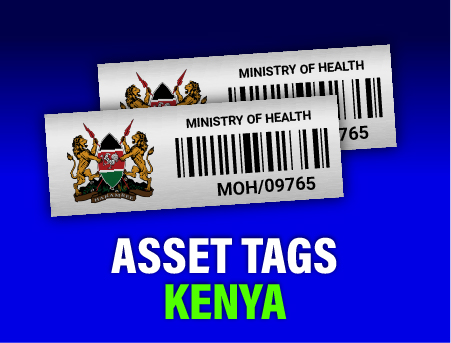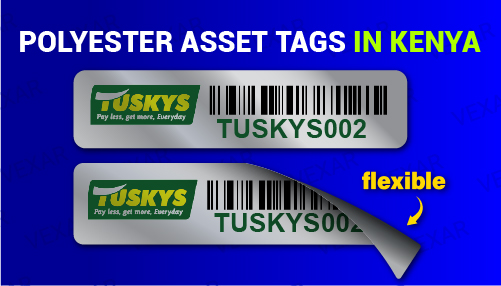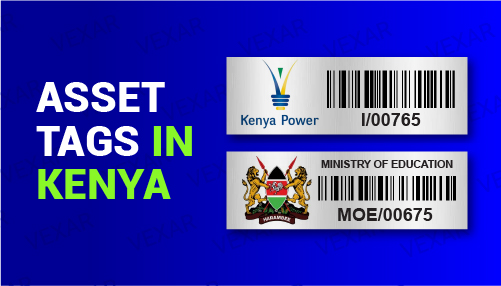Acetone Activated Asset Tags Kenya – Permanent Labels That Never Peel Off
Acetone Activated Asset Tags Kenya are engineered for environments where standard labels fail. Built from high-quality anodized aluminium and bonded using acetone/paint thinner, these labels chemically fuse with the surface, creating a permanent mark that will not peel, fade, or detach — even under extreme heat, solvents, or constant use. For businesses seeking lifetime durability and tamper-proof asset identification, these asset tags are a proven solution trusted by organizations across Kenya.
What Are Acetone Activated Asset Tags?
Acetone activated asset tags are not ordinary stickers. They’re a specialized form of aluminium asset tags designed for permanent adhesion through a chemical reaction. When acetone or paint thinner is applied, the tag’s backing dissolves slightly, allowing the aluminium surface to bond directly to the material beneath. This results in a tamper-evident connection that physically integrates the tag into the item, making it impossible to remove without leaving clear damage.
These tags are ideal for environments where durability, legibility, and tamper resistance are crucial — from manufacturing plants to hospitals, schools, laboratories, and government facilities. In essence, acetone-activated labels are the gold standard in fixed asset tagging and industrial marking.
Why Choose Acetone Activated Tags in Kenya?
Kenyan businesses are increasingly recognizing the long-term value of permanent asset identification. Unlike adhesive or vinyl labels, acetone-activated aluminium tags bond chemically with the surface — forming an unbreakable link between tag and equipment. This ensures your identification labels survive for years, even in hot warehouses, oily workshops, or outdoor environments exposed to UV rays and rain.
These tags also enhance accountability. Once an item is labeled, it’s permanently traceable, reducing theft, loss, and misplacement. Government offices, NGOs, and schools that need consistent, auditable tagging solutions rely on them to maintain clear asset histories and prevent tampering or switching of tags between assets.
Permanent Aluminium Labels That Outperform Stickers
Ordinary sticker-based labels can peel off due to humidity, temperature changes, or cleaning solvents. But acetone activated aluminium tags don’t rely on glue — they rely on chemistry. The moment acetone is applied, the tag becomes part of the surface itself. This unique bonding process guarantees unparalleled strength and resilience compared to self-adhesive asset tags or vinyl labels.
Even after years of use, the printed information remains sharp and readable. The graphics, barcodes, and serial numbers are sealed under the anodized layer, ensuring they can’t be scratched or faded by regular handling. That makes these labels perfect for industrial equipment, IT assets, laboratory apparatus, or outdoor installations.
Applications Across Industries
Acetone-activated aluminium labels serve a wide range of applications across Kenya:
- Government and NGOs: Used for tagging furniture, electronics, and vehicles to maintain accurate asset registers.
- Manufacturing: Ideal for identifying machinery and production tools exposed to heat or chemicals.
- Healthcare: Hospitals use them for durable, hygienic tagging of medical instruments and diagnostic equipment.
- Education: Universities and schools rely on them for permanent labeling of lab equipment and computers.
- Logistics and Warehousing: They ensure long-term visibility for inventory and transport containers.
In every case, acetone-activated aluminium labels help organizations maintain order, prevent fraud, and support efficient audits. They integrate seamlessly with QR code aluminium tags and barcode asset labels, enabling instant digital tracking.
How to Apply Acetone Activated Labels
Installation is simple yet precise. Here’s a step-by-step method to ensure a perfect bond:
- Clean the surface: Wipe away any oil, dust, or old adhesive from the target area.
- Apply acetone or paint thinner: Lightly wet the area using a clean lint-free cloth or brush.
- Position the tag: Carefully place the aluminium tag on the prepared spot before the acetone evaporates.
- Press firmly: Hold the tag for 20–30 seconds to allow full chemical activation and bonding.
- Inspect: Once set, the tag becomes part of the surface — no edges, no air bubbles, and no peeling.
This bonding technique ensures that even if someone tries to remove the label, the surface underneath will show visible damage, instantly revealing tampering. Learn more about chemical bonding adhesives from Adhesives.org to understand why this process delivers such unmatched durability.
Enhanced Asset Security and Brand Identity
Each tag can be custom-printed with your company logo, sequential numbering, and barcodes for traceability. This not only enhances brand visibility but also builds asset security and accountability. Vexar Solutions offers custom asset tag printing with variable data, QR codes, and company branding to suit diverse needs.
Additionally, acetone-activated labels help maintain consistent visual identity across multiple branches or departments, ensuring uniformity in asset management systems. Combined with asset management software, these tags simplify data entry and improve the accuracy of asset registers.
Durability Tested in Real Conditions
Our acetone activated aluminium labels have been tested in Kenya’s varied environmental conditions — from coastal humidity to industrial heat. They maintain adhesion and legibility even under constant exposure to moisture, oil, and UV light. The anodized finish provides corrosion resistance, while the permanent bond prevents lifting or chipping.
Many clients who previously used sticker-based tags have switched to acetone-activated ones after experiencing issues like label peeling or fading within months. With these permanent labels, businesses enjoy peace of mind, knowing their identification system will last for years without replacement.
Comparison with Other Tag Types
Compared to polyester asset tags, which rely on adhesive, acetone-activated aluminium tags are far more durable. Unlike tamper-proof stickers, they can withstand industrial solvents, abrasions, and outdoor exposure. Even laser-marked tags, while permanent, may not achieve the same bonding strength on non-metallic surfaces.
For businesses needing a middle ground between cost and permanence, explore cost-effective barcode tags. But when permanence is non-negotiable, acetone-activated aluminium tags remain the superior choice.
Smarter Asset Tracking with Vexar Solutions
At Vexar Solutions, we provide complete end-to-end asset tagging solutions — from design and printing to installation and digital mapping. Our team ensures each acetone-activated tag is properly applied, verified, and linked to your database for instant lookup and reporting. This holistic approach minimizes human error and enhances audit transparency.
We also offer specialized options such as tamper-proof aluminium asset tags and anodized aluminium tags for regional operations across Africa. Combined, these solutions deliver unmatched value and professionalism for asset tracking and compliance management.
Conclusion
When it comes to permanent labeling, Acetone Activated Asset Tags Kenya stand in a class of their own. Their unique chemical bond ensures they never peel, fade, or loosen — no matter how demanding the environment. For businesses, institutions, and industries seeking lifetime identification and tamper-proof durability, these tags are not just an upgrade — they’re a necessity.
Explore more durable tagging solutions and see how we can help you streamline your asset tracking at Vexar Solutions.







